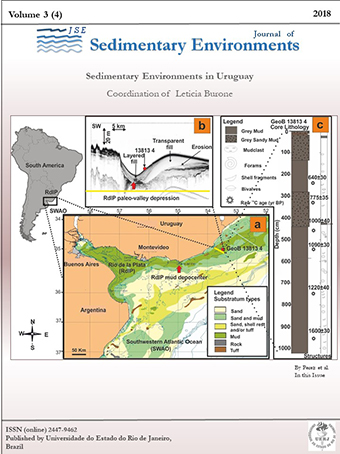CLIMATIC, ENVIRONMENTAL AND OCEANOGRAPHIC CHANGES OVER THE PAST MILLENNIUM, RECONSTRUCTED FROM A PALYNOLOGICAL RECORD OF THE INNER URUGUAYAN CONTINENTAL SHELF / MUDANÇAS CLIMÁTICAS, AMBIENTAIS E OCEANOGRÁFICAS DO ÚLTIMO MILÉNIO, RECONSTRUÍDAS A PARTIR DE UM REGISTRO PALINÓNICO DA PLATAFORMA CONTINENTAL INTERNA URUGUAIA
DOI:
https://doi.org/10.12957/jse.2018.39141Keywords:
Palynology. Dinocysts. Diatoms. Southeastern South America. Southwestern Atlantic Ocean. Past climate. / Palavras-chave, Palinologia. Dinocistos. Diatomáceas. Sudeste da América do Sul. Sudoeste do Oceano Atlântico. Clima passado.Abstract
In order to strengthen and update knowledge on climatic, environmental and oceanographic changes on the inner Uruguayan continental shelf, we studied pollen, dinocyst and other non-pollen palynomorph assemblages on the sediment core GeoB13813-4. This core was taken from the mud depocenter and its remarkable high sedimentation rate for the last ca. 1000 yr cal BP reflects the high terrigenous supply from the Rio de la Plata (RdlP). Most pollen and spores are originated from the RdlP grasslands, the vegetation that covers the lower reaches of the La Plata Drainage Basin (LPDB). They mainly represent the regionally dominant grasslands, but also the riparian forests, Butia yatay palm populations, and the herbaceous-bushy marshes around the mouth of the estuary. Pollen from salt marshes, Atlantic rainforest, and Araucaria forests located in southern Brazil reached the study site, probably transported by coastal ocean currents, whereas pollen from Andean regions would represent a long-distance transport by wind. Changes in both proportion and concentration of freshwater and marine palynomorphs indicate variability in freshwater input to the inner Uruguayan shelf. From ca. 1000 to 230 yr cal BP, significant marine influence of Subtropical Shelf Waters (STSW) was inferred, which was diluted by the freshwater supply from the Uruguayan mainland. This time interval was interrupted between ca. 690 to 575 yr cal BP by an increased freshwater contribution to the study area under the influence of Subantarctic Shelf Waters (SASW). From ca. 230 to 25 yr cal BP, a strong influence of RdlP waters was detected, only followed by another phase of dominant STSW during the past century. Such changes were related to regional climatic variability, i.e., Medieval Climate Anomaly, Little Ice Age and Current Warm Period. After ca. 1960 AD, the anthropogenic impact within the LPDB was clearly evidenced both by eutrophication and the first occurrence of Pinus pollen.Resumo
A fim de melhorar e atualizar o conhecimento sobre mudanças climáticas, ambientais e oceanográficas na Plataforma Continental Uruguaia, foi estudado o pólen, os dinocistos e outras associações de palinomorfos não polínicos no testemunho de sedimentos GeoB13813-4. Este testemunho foi recolhido no depósito lodoso e a sua taxa de sedimentação durante os últimos ≈1000 anos antes do presente (BP; before present) reflete o elevado contributo terrígeno do Río de la Plata (RdlP) á área de estudo. Os resultados obtidos revelam que a maioria dos pólenes e esporos é originária das pastagens e da vegetação que cobre o curso inferior da Bacia de Drenagem do Río de la Plata (LPDB). Representam principalmente as pastagens, as quais são regionalmente dominantes, mas também matas ciliares, populações da palmeira Butia yatay e sapais herbáceos ao redor da foz do estuário. Pólen de sapais, Mata Atlântica e florestas de Araucária localizadas no sul do Brasil chegaram ao local de estudo, provavelmente transportados por correntes oceânicas costeiras. O pólen das regiões andinas poderá representar um transporte de longa distância pelo vento. Mudanças na proporção e concentração de palinomorfos de água doce e marinhos indicam variabilidade na entrada de água doce na plataforma continental interna uruguaia. Entre ≈1000-230 anos BP, os dados indicam a ocorrência de uma significativa influência marinha das Águas Subtropicais da Plataforma (STSW), misturadas com água doce do continente uruguaio. Este intervalo foi marcado, entre ≈690-575 anos BP, com uma maior contribuição de água doce para a área de estudo sob a influência de Águas Subantárticas (SASW). Entre ≈230-25 anos BP, foi detectada uma forte influência das águas do RdlP. Esta fase foi seguida, durante o século passado, por outra em que as STSW foram dominantes. Tais mudanças poderão ter sido causadas pela variabilidade climática regional, ou seja, Anomalia Climática Medieval, Pequena Idade do Gelo e Período Quente Atual. Desde ≈1960, o impacto antropogênico no LPDB está claramente evidenciado tanto pela eutrofização quanto pela primeira ocorrência de pólen de Pinus.
Downloads
Published
Issue
Section
License

Journal of Sedimentary Environments (JSE) is licensed under a Creative Commons Attribution-Noncommercial-Share Alike 4.0 International License.

